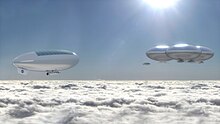
Summary
High Altitude Venus Operational Concept (HAVOC) is a set of crewed NASA mission concepts to the planet Venus. All human portions of the missions would be conducted from lighter-than-air craft or from orbit.[1] A similar concept, the "Floating Islands of Venus", was proposed by Soviet engineer and sci-fi writer Sergei Zhitomirsky in 1971.[2][3]

Background edit
Human missions to Venus have historically been thought impractical, if not impossible. However, Venus has advantages for crewed travel, such as being closer than Mars, an Earth-like gravity (0.9 g) and an atmosphere that provides a level of protection from solar and interstellar radiation.[1]
Whereas all ground missions measured their operational time in minutes or hours, the Soviet Vega missions found success in launching small balloons, that operated until their batteries were exhausted (days).[4] At 55 km (34 mi) altitude, the atmosphere of Venus is 27 °C (81 °F) and 0.5 bar (50 kPa) (the equivalent pressure at an elevation of about 5,500 m (18,000 ft) on Earth). However, due to the large amount of CO
2, the density for a given pressure is greater than in Earth's atmosphere. Therefore breathable air acts as a buoyant gas. At the same time, the gravity at the proposed altitude is 8.73 m/s2 versus 9.81 m/s2 on Earth's surface.[citation needed]
Venus has an induced magnetosphere from the interaction of its thick atmosphere with the solar wind, and its nearer proximity to the Sun brings it further within the Sun's magnetic field, which decreases the interstellar radiation levels. With the addition of the reduced deep space exposure time, the radiation levels anticipated by astronauts are much less than an equivalent Mars mission.[1][5]
Mission concepts edit
Phase 1 edit
Phase 1 involves a robotic exploration via a 31-metre-long (102 ft), 8-metre-tall (26 ft), airship.[1]: 11 It would be used to test many of the technologies that would be used in the crewed version, including the airship, energy systems, and aerocapture and descent sled.
Phase 2 edit
Phase 2 is for astronauts to orbit Venus. The individual components would be assembled remotely, and the crew would join the larger assembly when all the preparations are complete. There would be a return module sent to low Venus orbit ahead of the astronauts, with which they would rendezvous in Venusian orbit, before returning to Earth.
Phase 3 edit
Phase 3 involves astronauts descending into the atmosphere, for 30 Earth days. The airship for this would be 129 metres (423 ft) long and 34 metres (112 ft) tall. The aeroshell would be used for heat dissipation. A parachute would be deployed to further slow the craft, before finally inflating the airship. Once inflated, the crew would live in the airship for a period equivalent to thirty Earth days, before detaching and ascending in the Venus Ascent Vehicle.[1]: 13–21
The outward journey for this phase would take 110 [Earth] days, and the return 300. The total mission time would thus be 440 days.[1]: 16
Phase 4 edit
Phase 4 of the concept is to send humans into the atmosphere of Venus for 1 [Earth] year,[1]: 7 similar to Phase 3 but longer.
Phase 5 edit
Phase 5 is introducing a permanent human presence, in the Venusian atmosphere,[1]: 7 by way of a permanent space station-type spacecraft.
See also edit
References edit
- ^ a b c d e f g h Arney, Dale; Jones, Chris (2015). HAVOC: High Altitude Venus Operational Concept - An Exploration Strategy for Venus. SPACE 2015: AIAA Space and Astronautics Forum and Exposition. 31 August-2 September 2015. Pasadena, California. NF1676L-20719.
- ^ "сказали ученые, обобщив результаты исследований АМС «Магеллан»". Tekhnika Molodezhi. March 1997. Retrieved May 30, 2023.
- ^ "Crazy ideas Soviets imagined for space colonization (PICS)". Russia Beyond. 20 April 2020. Retrieved May 30, 2023.
- ^ Preston, R. A.; et al. (March 1986). "Determination of Venus Winds by Ground-Based Radio Tracking of the VEGA Balloons". Science. 231 (4744): 1414–1416. Bibcode:1986Sci...231.1414P. doi:10.1126/science.231.4744.1414. PMID 17748082. S2CID 29444555.
- ^ Landis, Geoffrey A. (Feb 2–6, 2003). Colonization of Venus. Conference on Human Space Exploration, Space Technology & Applications International Forum. Vol. 654. Albuquerque New Mexico. pp. 1193–1198. Bibcode:2003AIPC..654.1193L. doi:10.1063/1.1541418.; draft version of the full paper available at NASA Technical Reports Server (accessed 16 May 2012)
External links edit
- Media related to High Altitude Venus Operational Concept at Wikimedia Commons
- NASA concept page
- NASA animation of HAVOC in action


